Instability Characteristics of and Control Techniques for Mudstone–Clay Composite Roof Roadways
Abstract
1. Introduction
2. Engineering Background
3. Microscopic Experimental Study on Mudstone–Clay
3.1. Experimental Methods
3.2. Analysis of Mudstone–Clay Experimental Results
3.2.1. XRD Experimental Analysis
3.2.2. SEM Scanning Experimental Analysis
3.2.3. Uniaxial Compression Analysis
3.3. Failure Modes of Composites
4. Deformation and Instability Law and Prevention Technology of Double Soft Composite Roof
4.1. Orthogonal Experimental Analysis
4.1.1. Scheme Design
4.1.2. Simulation Results of Roof Migration
4.2. Sensitivity Analysis of Influencing Factors
4.2.1. Orthogonal Experiment Range Analysis
4.2.2. Orthogonal Experiment’s Analysis of Variance
4.3. Prevention Techniques for Roadway Deformation
4.3.1. Principle of Roof Support Prevention and Control
4.3.2. Design of Roof Support Parameters
4.3.3. Analysis of Engineering Site Effects
- (1)
- Initial Excavation Impact Stage
- (2)
- Excavation General Impact Stage
- (3)
- Excavation Affects Stability Stage
5. Conclusions
- The inherent structure of mudstone and clay features extensive cracks and pores, with relatively independent particles, facilitating water infiltration. The high content of kaolin in clay, characterized by strong hydrophilicity and plasticity, significantly influences roadway roof stability and subsidence behavior;
- Uniaxial compressive strength tests demonstrated that the moisture content of the clay layer greatly influences the mechanical properties and failure behavior of the composite roof. Saturated clay composites exhibited lower strength and predominantly tensile failure compared to dry clay composites;
- The distance between the clay layer and roadway roof shows a negative correlation with the maximum roof subsidence. The clay layer’s thickness is positively correlated with the roof subsidence—thicker layers lead to a greater maximum subsidence. An increase in the number of clay layers results in an overall greater subsidence. The relative moisture content in the clay layer is most sensitive to the roadway roof stability, followed by the thickness and number of clay layers;
- The combined support system of anchor rods, short anchor cables, and long anchor cables creates a stress superposition in the surrounding rock. This integrated approach expands the bearing area above the roadway, allowing a larger rock mass to share the load, thereby ensuring the safety of the surrounding rock in the mudstone–clay composite roof coal roadway.
Author Contributions
Funding
Institutional Review Board Statement
Informed Consent Statement
Data Availability Statement
Conflicts of Interest
Abbreviations
| XRD | X-ray diffraction |
| PSP | Multidisciplinary Digital Publishing Institute |
| SEM | Scanning Electron Microscope |
References
- Wang, Z.; Wang, M.; Zhou, L.; Zhu, Z.; Shu, Y.; Peng, T. Research on uniaxial compression strength and failure properties of stratified rock mass. Theor. Appl. Fract. Mech. 2022, 121, 103499. [Google Scholar] [CrossRef]
- Chen, J.; Liu, W.; Chen, L.; Luo, Y.; Li, Y.; Gao, H.; Zhong, D. Failure mechanisms and modes of tunnels in monoclinic and soft-hard interbedded rocks: A case study. KSCE J. Civ. Eng. 2020, 24, 1357–1373. [Google Scholar] [CrossRef]
- Duffaut, P. Structural weaknesses in rocks and rock masses tentative classification and behaviour. In Proceedings of the ISRM International Symposium, International Society for Rock Mechanics, Tokyo, Japan, 21–24 September 1981; pp. 93–97. [Google Scholar]
- Liu, Y.; Zheng, P.; Xu, L.; Li, W.; Sun, Y.; Sun, W.; Yuan, Z. Mechanism of roof deformation and support optimization of deeply buried roadway under mining conditions. Appl. Sci. 2022, 12, 12090. [Google Scholar] [CrossRef]
- Duan, S.Q.; Jiang, Q.; Liu, G.F.; Jie, C.X.; Gao, P.; Xu, D.; Li, M. An insight into the excavation-induced stress paths on mechanical response of weak interlayer zone in underground cavern under high geostress. Rock Mech. Rock Eng. 2021, 54, 1331–1354. [Google Scholar] [CrossRef]
- Duan, S.; Jiang, Q.; Xu, D.; Liu, G. Experimental study of mechanical behavior of interlayer staggered zone under cyclic loading and unloading condition. Int. J. Geomech. 2020, 20, 04019187. [Google Scholar] [CrossRef]
- Duan, S.Q.; Feng, X.T.; Jiang, Q.; Liu, G.; Pei, S.; Fan, L. In situ observation of failure mechanisms controlled by rock masses with weak interlayer zones in large underground cavern excavations under high geostress. Rock Mech. Rock Eng. 2017, 50, 2465–2493. [Google Scholar] [CrossRef]
- Wang, Y.; Pu, Z.; Ge, Q.; Liu, J. Study on the water-richness law and zoning assessment of mine water-bearing aquifers based on sedimentary characteristics. Sci. Rep. 2022, 12, 14107. [Google Scholar] [CrossRef]
- Wang, Y.; Li, M. Research on the deformation law of jointed surrounding rock during tunnel excavation based on hydromechanical coupling. Geofluids 2021, 2021, 5583940. [Google Scholar] [CrossRef]
- Kuforiji, H.I.; Olurin, O.T.; Akinyemi, O.D.; Idowu, O.A. Wave velocity variation with temperature: Influential properties of temperature coefficient (∂V/∂T) of selected rocks. Environ. Earth Sci. 2021, 80, 638. [Google Scholar] [CrossRef]
- Gautam, T.P.; Shakoor, A. Slaking behavior of clay-bearing rocks during a one-year exposure to natural climatic conditions. Eng. Geol. 2013, 166, 17–25. [Google Scholar] [CrossRef]
- Xu, J.; Kang, Y.; Wang, X.; Feng, G.; Wang, Z. Dynamic characteristics and safety criterion of deep rock mine opening under blast loading. Int. J. Rock Mech. Min. Sci. 2019, 119, 156–167. [Google Scholar] [CrossRef]
- Chen, S.; Qiao, C.; Yang, Z.; Qiao, C. Application of stochastic joint network simulation to composite strata of shallow-buried long-span metro tunnels. Bull. Eng. Geol. Environ. 2020, 79, 2085–2107. [Google Scholar] [CrossRef]
- Liu, X.; Li, Y.; Li, S.; Zhou, Y. Research on the disintegration characteristics of carbonaceous mudstone and properties of modified materials. Adv. Civ. Eng. 2019, 2019, 4382054. [Google Scholar] [CrossRef]
- Zeng, L.; Yu, H.C.; Qiu, J.; Luo, J.; Liu, J.; Gao, Q.; Zhang, H. Pore characteristics and microscopic damage mechanism of disintegrated carbonaceous mudstone exposed to dry-wet cycles. Constr. Build. Mater. 2024, 433, 136774. [Google Scholar] [CrossRef]
- Chen, C.; Fu, H.; Gao, Q.F.; Zeng, L.; Jia, C. Polyurea reinforcement of disintegrated mudstone embankments and the underlying mechanism. Transp. Geotech. 2022, 37, 100874. [Google Scholar] [CrossRef]
- Gao, Q.; Shi, Z.; Luo, J.; Liu, J. Microstructural insight into permeability and water retention property of compacted binary silty clay. J. Cent. South Univ. 2020, 27, 2068–2081. [Google Scholar] [CrossRef]
- Liu, W.; Tang, X.; Yang, Q.; Li, W. Influence of drying/wetting cycles on the mechanical cyclic behaviours of silty clay. Eur. J. Environ. Civ. Eng. 2015, 19, 867–883. [Google Scholar] [CrossRef]
- Li, Y.; Yang, R.; Fang, S.; Lin, H.; Lu, S.; Zhu, Y.; Wang, M. Failure analysis and control measures of deep roadway with composite roof: A case study. Int. J. Coal Sci. Technol. 2022, 9, 2. [Google Scholar] [CrossRef]
- Zhao, M.; Yang, R.; Fang, J. Stability and control technology for coal roadway of composite roof with thin-layered and argillaceous. J. Compos. Adv. Mater./Rev. Compos. Matériaux Avancés 2018, 28, 239. [Google Scholar]
- Wang, P.; Zhang, N.; Kan, J.; Xu, X.; Cui, G. Instability mode and control technology of surrounding rock in composite roof coal roadway under multiple dynamic pressure disturbances. Geofluids 2022, 2022, 8694325. [Google Scholar] [CrossRef]
- Shi, L.; Zhou, H.; Song, M.; Lu, J.; Liu, Z. Geomechanical model test for analysis of surrounding rock behaviours in composite strata. J. Rock Mech. Geotech. Eng. 2021, 13, 774–786. [Google Scholar] [CrossRef]
- Wang, Z.; Wang, Y.; Liu, Q.; Dino, G.; Ruan, Z.; Wu, A. Impact of weak interlayer characteristics on the mechanical behavior and failure modes of cemented tailings backfill: A study on thickness, strength, and dip angle. Eng. Fail. Anal. 2024, 165, 108795. [Google Scholar] [CrossRef]
- Zhao, H.; Deng, B.; Zhang, D.; Li, M.; Song, Z. Influence of weak interlayer thickness on mechanical response and failure behavior of rock under true triaxial stress condition. Eng. Fail. Anal. 2024, 162, 108419. [Google Scholar] [CrossRef]
- Liu, H.; Liu, C.; Yue, X.; Wang, J. Study on mechanical properties and acoustic emission characteristics of mudstone-clay composites under uniaxial compression. Eng. Geol. 2024, 332, 107478. [Google Scholar] [CrossRef]
- Zheng, W.; Guo, Y.; Zhi, G.; Bao, X.; Sun, M.; Ren, R.; Duan, Z.; Gao, Z. Stability Analysis and Control Measures of Large-Span Open-Off Cut with Argillaceous Cemented Sandstone Layered Roof. Math. Probl. Eng. 2021, 2021, 8744081. [Google Scholar] [CrossRef]
- Sun, B.; Mei, Y.; Li, W.; Shao, X.; Li, T.; Li, W.; Zhao, W.; Wang, L. Experimental study on the deformation and failure mode of surrounding rocks of a tunnel in a jointed rock mass. Eng. Fail. Anal. 2024, 163, 108470. [Google Scholar] [CrossRef]
- Zhang, H.; Li, Y.; Wang, X.; Yu, S.; Wang, Y. Study on stability control mechanism of deep soft rock roadway and active support technology of bolt-grouting flexible bolt. Minerals 2023, 13, 409. [Google Scholar] [CrossRef]
- Liu, C.; Li, Y. Predicting the shear resistance contribution of passive fully grouted bolts to jointed rock. Int. J. Geomech. 2020, 20, 04019174. [Google Scholar] [CrossRef]
- Chen, Y.; Li, Q.; Pu, H.; Wu, P.; Chen, L.; Qian, D.; Shi, X.; Zhang, K.; Mao, X. Modeling and simulation of deformation mechanism of soft rock roadway considering the mine water. Geofluids 2020, 2020, 8812470. [Google Scholar] [CrossRef]
- Zang, C.W.; Chen, Y.; Chen, M.; Zhu, H.; Qu, C.; Zhou, J. Research on deformation characteristics and control technology of soft rock roadway under dynamic disturbance. Shock. Vib. 2021, 2021, 6625233. [Google Scholar] [CrossRef]
- Bai, X.; Ding, H.; Lian, J.; Ma, D.; Yang, X.; Sun, N.; Xue, W.; Chang, Y. Coal production in China: Past, present, and future projections. Int. Geol. Rev. 2017, 1301226, 535–547. [Google Scholar]
- Yossifova, M.G.; Dimitrova, D.A.; Ivanova, R.I. Mineral and chemical composition of some claystones from the Troyanovo-3 mine, Maritsa East lignite basin, Bulgaria. Int. J. Coal Geol. 2018, 196, 93–105. [Google Scholar] [CrossRef]
- Seedsman, R. Application of the Brittle Failure Criterion to the Design of Roof Support in The Soft Rocks of Coal Mines. In Proceedings of the 11th Underground Coal Operators’ Conference, Wollongong, Australia, 10–11 February 2011; pp. 60–72. [Google Scholar]
- Downs, R.T.; Hall-Wallace, M. The American Mineralogist crystal structure database. Am. Mineral. 2003, 88, 247–250. [Google Scholar]
- Li, Y.; She, L.; Wen, L.; Zhang, Q. Sensitivity analysis of drilling parameters in rock rotary drilling process based on orthogonal test method. Eng. Geol. 2020, 270, 105576. [Google Scholar] [CrossRef]
- Yan, G.; Zheng, Y.; Wang, L.; Huang, Z. Optimization of stamping process parameters based on orthogonal test and intelligent algorithm. In Proceedings of the 2020 3rd World Conference on Mechanical Engineering and Intelligent Manufacturing (WCMEIM), Shanghai, China, 4–6 December 2020; pp. 393–397. [Google Scholar]
- Jiang, B.; Xia, W.; Wu, T.; Liang, J. The optimum proportion of hygroscopic properties of modified soil composites based on orthogonal test method. J. Clean. Prod. 2021, 278, 123828. [Google Scholar] [CrossRef]
- Xiang, H.; Lei, B.; Li, Z.; Zhao, K.; Lv, Q.; Zhang, Q.; Geng, Y. Analysis of parameter sensitivity of induction coil launcher based on orthogonal experimental method. IEEE Trans. Plasma Sci. 2015, 43, 1198–1202. [Google Scholar] [CrossRef]
- He, Q.S.; Liu, X.N.; Xiao, S.F. Application of orthogonal experimental design on reliability and sensitivity analysis. Adv. Mater. Res. 2011, 211, 651–655. [Google Scholar] [CrossRef]
- Wen, C.; Jia, S.; Fu, X.; Meng, L.; Zhao, Z. Experimental research and sensitivity analysis of mudstone similar materials based on orthogonal design. Adv. Mater. Sci. Eng. 2020, 2020, 2031276. [Google Scholar] [CrossRef]
- Liu, J.; Wang, Q.; Zhao, H.; Chen, J.; Qiu, Y.; Duan, D. Optimization design of the stratospheric airship’s power system based on the methodology of orthogonal experiment. J. Zhejiang Univ. Sci. A 2013, 14, 38–46. [Google Scholar] [CrossRef]
- Sun, D.; Liu, W.; Li, Z.; Zhan, X.; Dai, Q.; Xue, X.; Song, S. Numerical Experiment and Optimized Design of Pipeline Spraying On-Line Pesticide Mixing Apparatus Based on CFD Orthogonal Experiment. Agronomy 2022, 12, 1059. [Google Scholar] [CrossRef]
- Yang, W.; Meng, F.; Wu, D. Parametric Sensitivity Analysis and Efficiency Improvement of Electromagnetic Repulsion Mechanism Based on Orthogonal Experiment Design. In Proceedings of the IEEE International Magnetic Conference-Short Papers (INTERMAG Short Papers), Rio de Janeiro, Brazil, 5–10 May 2024; pp. 1–2. [Google Scholar]
- Yang, Y.; Xing, H.; Yang, X.; Chen, M.; Zhou, J. Experimental study on the dynamic response and stability of bedding rock slopes with weak interlayers under heavy rainfall. Environ. Earth Sci. 2018, 77, 433. [Google Scholar] [CrossRef]
- Liu, J.; Wang, E.; Song, D.; Wang, S.; Niu, Y. Effect of rock strength on failure mode and mechanical behavior of composite samples. Arab. J. Geosci. 2015, 8, 4527–4539. [Google Scholar] [CrossRef]
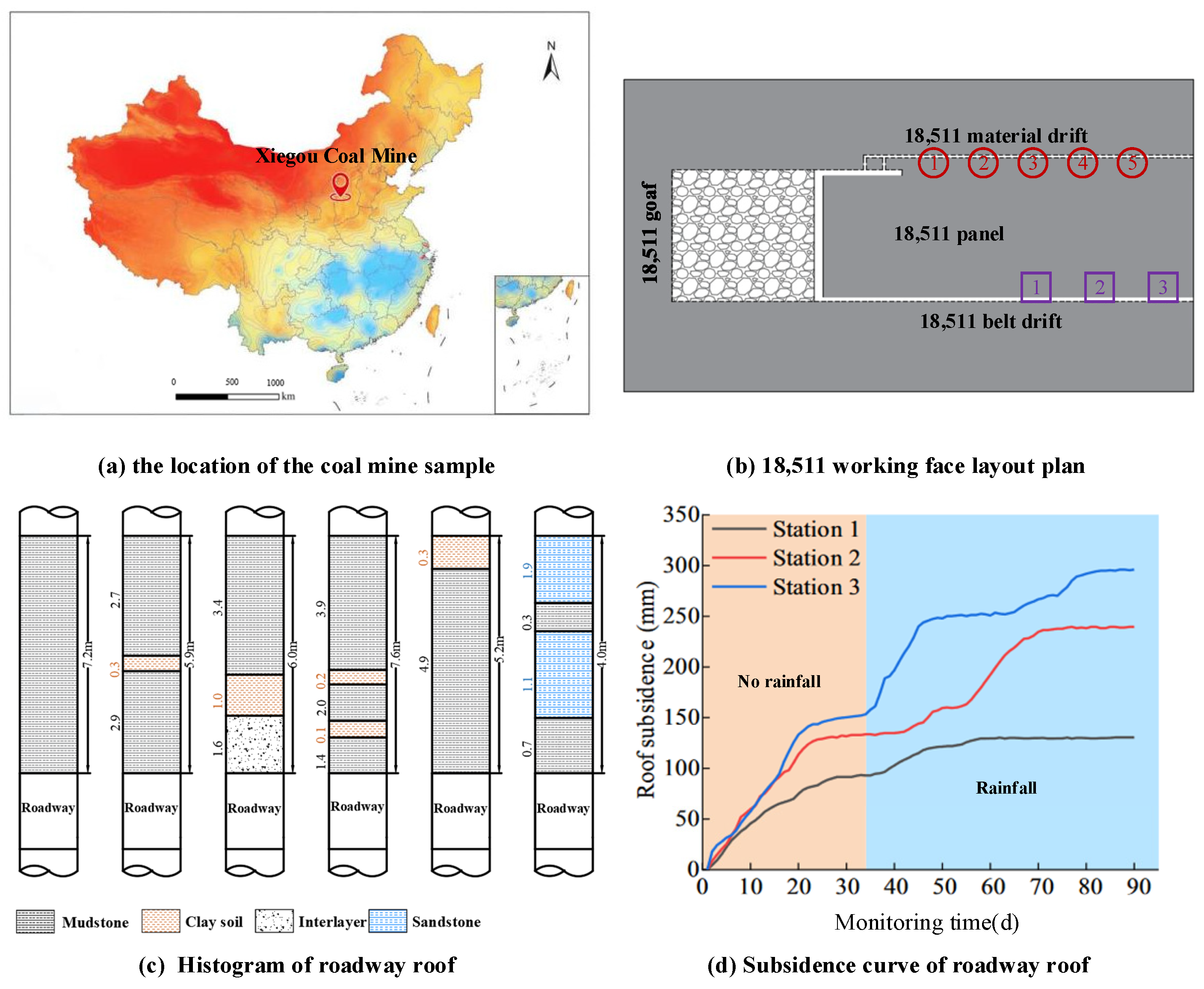

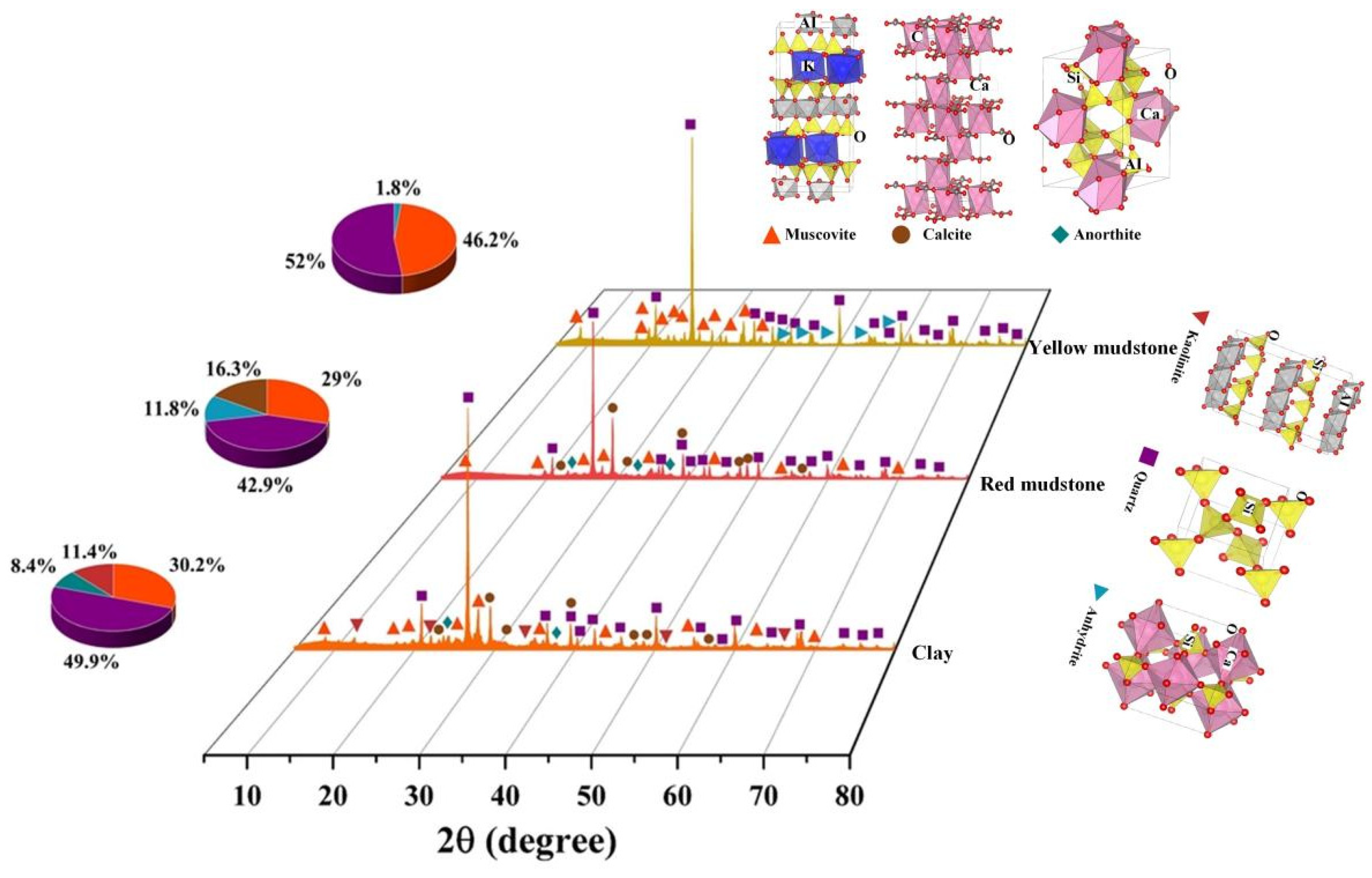



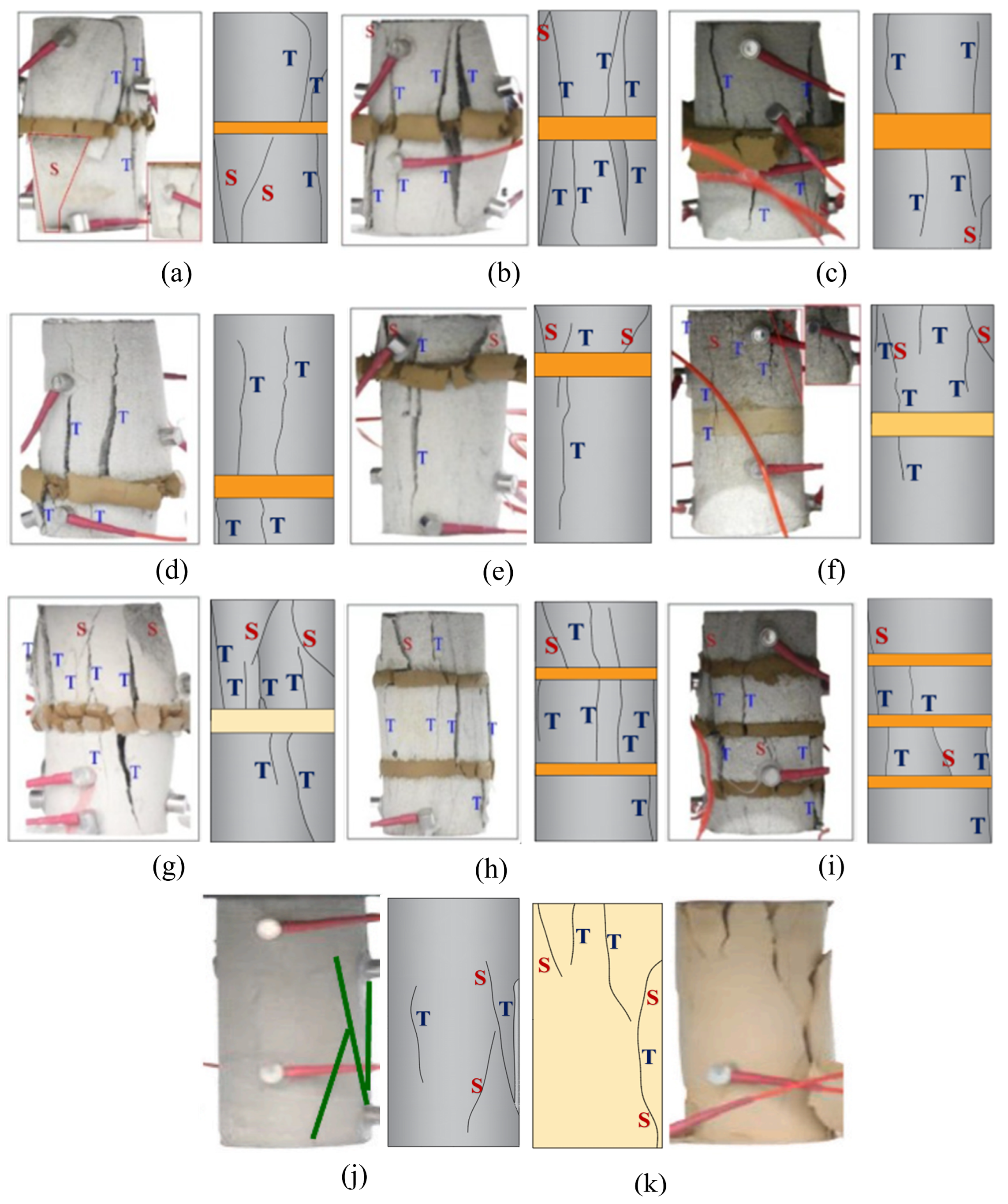

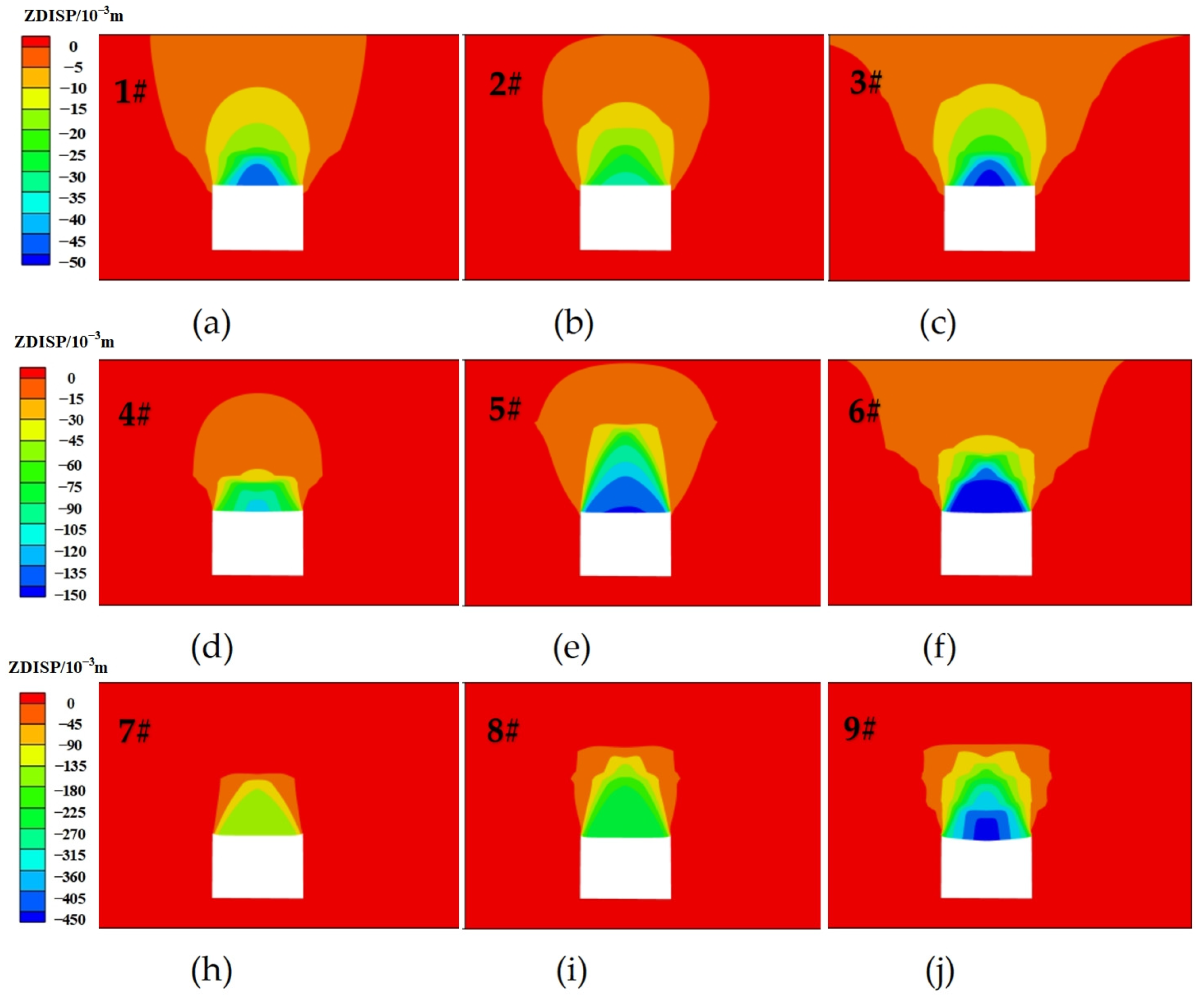
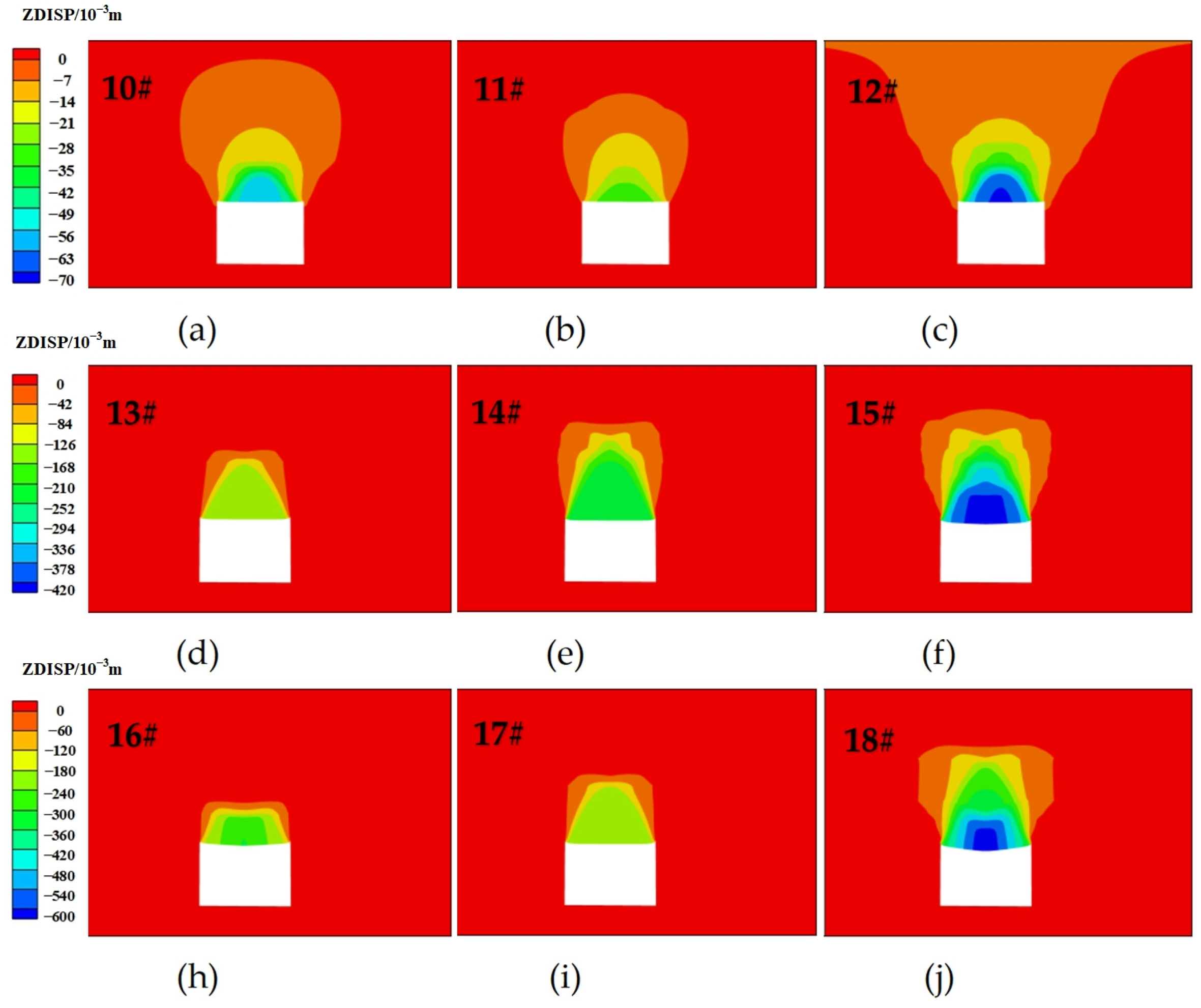


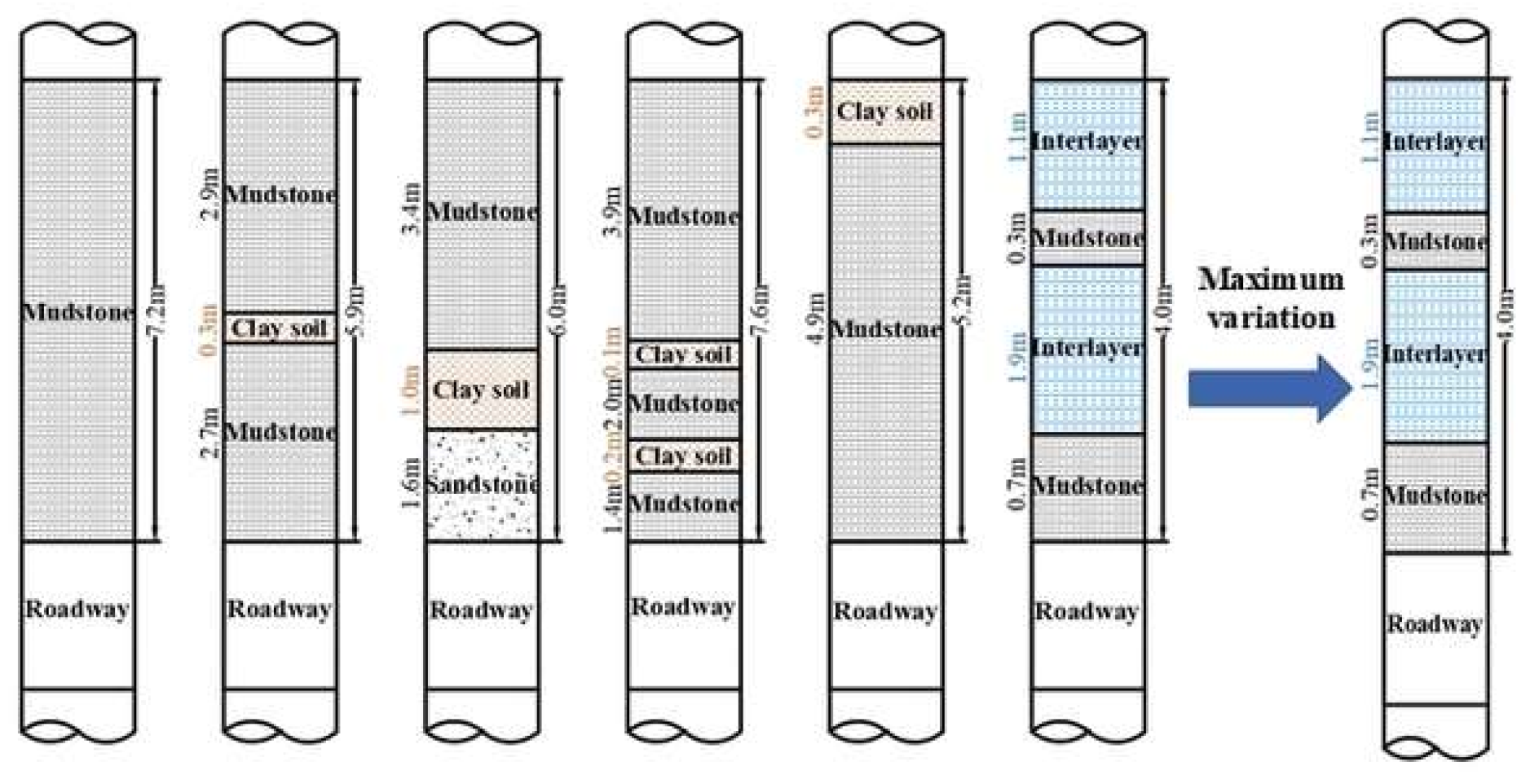


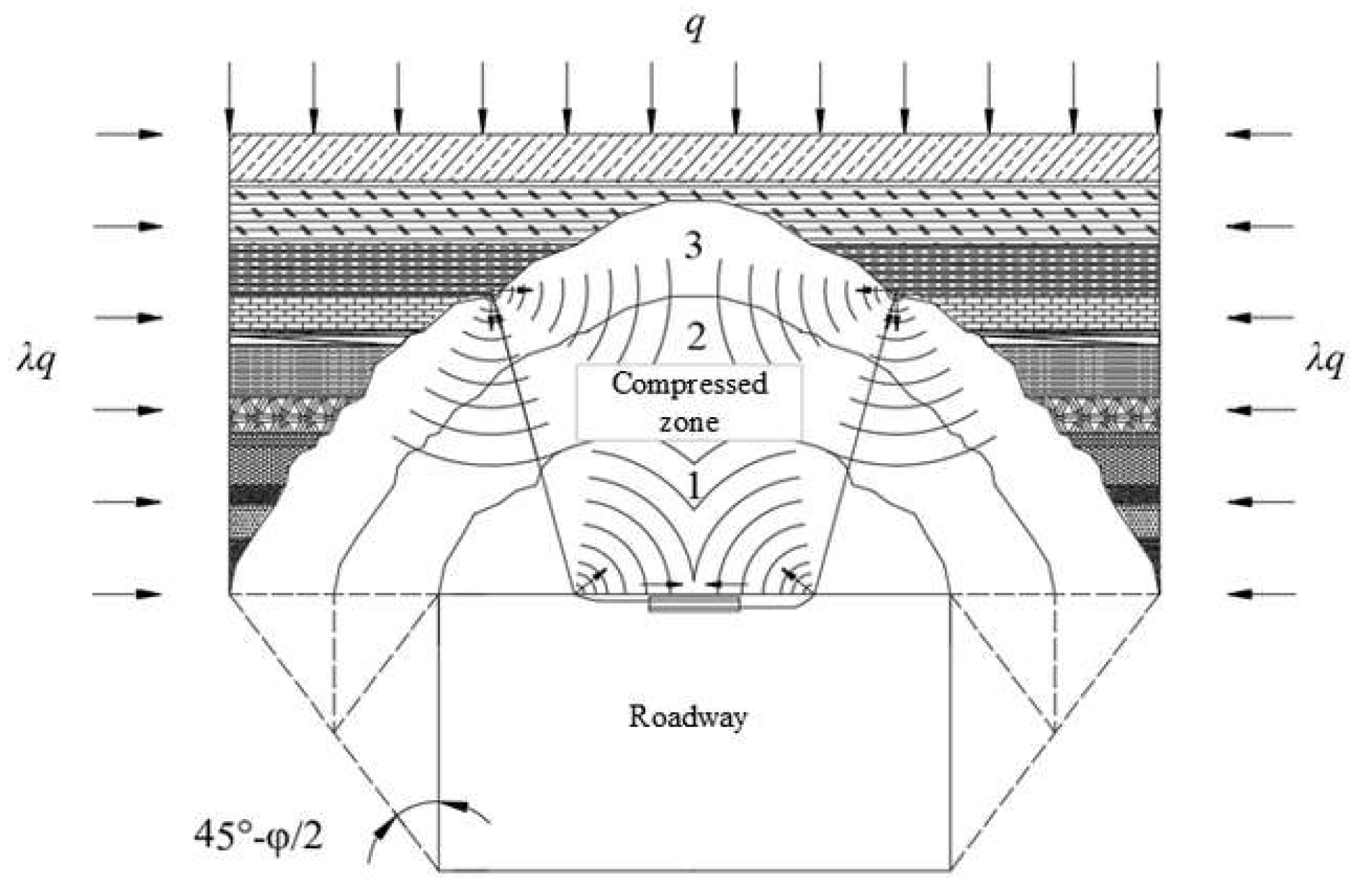


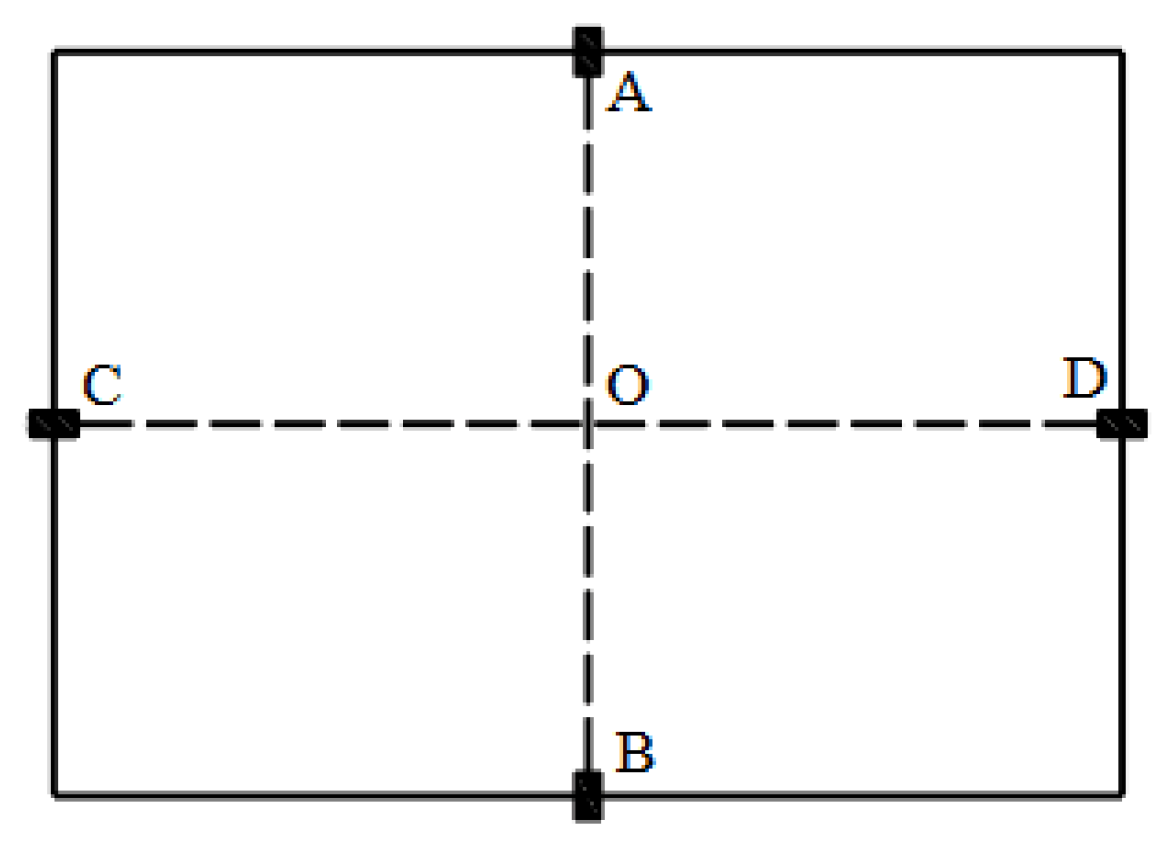

| Composite | Clay Layer Thickness | Clay Layer Position | Clay Layer Number | Moisture Content of Clay Layer | Experimental Purpose |
|---|---|---|---|---|---|
| T1 | 5 mm | 50 mm | 1 | 100% | Thickness variable |
| T2 | 10 mm | 50 mm | 1 | 100% | |
| T3 | 15 mm | 50 mm | 1 | 100% | |
| T4 | 10 mm | 25 mm | 1 | 100% | Layer variable |
| T5 | 10 mm | 75 mm | 1 | 100% | |
| T6 | 10 mm | 50 mm | 1 | 50% | Relative moisture content variable |
| T7 | 10 mm | 50 mm | 1 | 0% | |
| T8 | 5 mm | 30 + 70 mm | 2 | 100% | Layer variable |
| T9 | 5 mm | 25 + 50 + 75 mm | 3 | 100% | |
| T10 | 0 mm | / | / | 0% | Pure mudstone |
| T11 | 10 mm | / | / | 0% | Pure clay |
| Rock Layer Name | Density /kg·m−3 | Bulk Modulus /GPa | Shear Modulus /GPa | Tensile Strength /MPa | Internal Friction Angle /° | Cohesion /MPa |
|---|---|---|---|---|---|---|
| Mudstone | 2460 | 6.08 | 3.47 | 0.60 | 30.0 | 1.20 |
| Coarse sandstone | 2560 | 7.35 | 6.63 | 1.34 | 40.0 | 3.04 |
| Sandy mudstone | 2510 | 10.76 | 5.70 | 0.75 | 35.0 | 1.18 |
| Clay (Relative moisture content 0%) | 1960 | 0.12 | 0.04 | 0.14 | 17.6 | 0.36 |
| Clay (Relative moisture content 50%) | 1960 | 0.07 | 0.02 | 0.05 | 9.57 | 0.20 |
| Clay (Relative moisture content 100%) | 1960 | 0.04 | 0.02 | 0.00 | 6.29 | 0.13 |
| Middle sandstone | 2580 | 5.20 | 3.47 | 1.50 | 38.0 | 5.20 |
| Influence Factor | Level | ||||||
|---|---|---|---|---|---|---|---|
| 1 | 2 | 3 | 4 | 5 | 6 | 7 | |
| Layer thickness/m | 0.4 | 0.8 | 1.2 | ||||
| Moisture content/% | 0 | 50 | 100 | ||||
| Horizon/m | 1.5 | 3.0 | 4.5 | 1.5 + 3.0 | 1.5 + 4.5 | 3.0 + 4.5 | 1.5 + 3.0 + 4.5 |
| Scheme | Layer Thickness | Moisture Content | Horizon | Scheme | Layer Thickness | Moisture Content | Horizon | Scheme | Layer Thickness | Moisture Content | Horizon |
|---|---|---|---|---|---|---|---|---|---|---|---|
| 1# | 0.4 m | 0% | 1.5 m | 10# | 0.8 m | 0% | 1.5 m | 19# | 1.2 m | 0% | 3.0 m |
| 2# | 0.4 m | 0% | 3.0 m | 11# | 0.8 m | 0% | 4.5 m | 20# | 1.2 m | 0% | 3.0 + 4.5 m |
| 3# | 0.4 m | 0% | 4.5 m | 12# | 0.8 m | 0% | 1.5 + 3.0 m | 21# | 1.2 m | 0% | 1.5 + 3.0 + 4.5 m |
| 4# | 0.4 m | 50% | 1.5 m | 13# | 0.8 m | 50% | 3.0 m | 22# | 1.2 m | 50% | 1.5 m |
| 5# | 0.4 m | 50% | 4.5 m | 14# | 0.8 m | 50% | 3.0 + 4.5 m | 23# | 1.2 m | 50% | 3.0 m |
| 6# | 0.4 m | 50% | 1.5 + 3.0 m | 15# | 0.8 m | 50% | 1.5 + 3.0 + 4.5 m | 24# | 1.2 m | 50% | 1.5 + 4.5 m |
| 7# | 0.4 m | 100% | 3.0 m | 16# | 0.8 m | 100% | 1.5 m | 25# | 1.2 m | 100% | 1.5 m |
| 8# | 0.4 | 100 | 3.0 + 4.5 m | 17# | 0.8 | 100 | 3.0 m | 26# | 1.2 m | 100% | 4.5 m |
| 9# | 0.4 | 100 | 1.5 + 3.0 + 4.5 m | 18# | 0.8 | 100 | 1.5 + 4.5 m | 27# | 1.2 m | 100% | 1.5 + 3.0 m |
| Test Number | Roof Subsidence | Test Number | Roof Subsidence | Test Number | Roof Subsidence |
|---|---|---|---|---|---|
| 1# | 44.29 mm | 10# | 54.60 mm | 19# | 37.11 mm |
| 2# | 32.50 mm | 11# | 31.97 mm | 20# | 40.70 mm |
| 3# | 47.70 mm | 12# | 65.09 mm | 21# | 93.83 mm |
| 4# | 116.32 mm | 13# | 162.07 mm | 22# | 225.40 mm |
| 5# | 137.91 mm | 14# | 252.15 mm | 23# | 206.97 mm |
| 6# | 176.03 mm | 15# | 419.66 mm | 24# | 415.36 mm |
| 7# | 157.34 mm | 16# | 302.92 mm | 25# | 465.60 mm |
| 8# | 251.25 mm | 17# | 239.85 mm | 26# | 286.40 mm |
| 9# | 443.82 mm | 18# | 592.96 mm | 27# | 1103.20 mm |
| Index | Layer Thickness | Moisture Content | Horizon | Index | Layer Thickness | Moisture Content | Horizon |
|---|---|---|---|---|---|---|---|
| K1 | 469.05 | 149.26 | 1210.13 | 156.35 | 49.75 | 201.52 | |
| K2 | 23.70 | 39.70 | 45.30 | 235.70 | 234.65 | 139.30 | |
| K3 | 958.20 | 1140.40 | 321.37 | 319.40 | 380.13 | 159.18 | |
| K4 | 1348.32 | 448.10 | |||||
| K5 | 1061.02 | 352.00 | |||||
| K6 | 550.10 | 181.36 | |||||
| K7 | 964.31 | 319.10 | |||||
| Range R | 163.05 | 330.38 | 308.80 | Primary and secondary factors | 3 | 1 | 2 |
| Number of levels | 2 | 3 | 4 | 5 | 6 | 7 | 8 | 9 | 10 |
| Conversion factor | 0.71 | 0.52 | 0.45 | 0.40 | 0.37 | 0.35 | 0.34 | 0.32 | 0.31 |
| Source | Class III Sum of Squares | Freedom | Mean Square | F | p |
|---|---|---|---|---|---|
| Corrected model | 986,377.617 a | 10 | 98,637.762 | 4.101 | 0.006 |
| Intercept | 1,491,457.930 | 1 | 1,491,457.930 | 62.007 | 0.000 |
| Layer thickness | 91,080.828 | 2 | 45,540.414 | 1.893 | 0.183 |
| Moisture content | 644,248.955 | 2 | 322,124.477 | 13.392 | 0.000 |
| Layer | 251,047.835 | 6 | 41,841.306 | 1.740 | 0.176 |
| Error | 384,847.126 | 16 | 24,052.945 | ||
| Total | 2,800,921.645 | 27 | |||
| Revised total | 1,371,224.743 | 26 | |||
| R2 = 0.719 (After adjustment R2 = 0.544) | |||||
| p-Value Range | Level | Significance |
|---|---|---|
| p < 0.01 | I | Highly significant |
| 0.01 < p < 0.05 | II | Remarkable |
| p > 0.05 | III | Not significant |
Disclaimer/Publisher’s Note: The statements, opinions and data contained in all publications are solely those of the individual author(s) and contributor(s) and not of MDPI and/or the editor(s). MDPI and/or the editor(s) disclaim responsibility for any injury to people or property resulting from any ideas, methods, instructions or products referred to in the content. |
© 2025 by the authors. Licensee MDPI, Basel, Switzerland. This article is an open access article distributed under the terms and conditions of the Creative Commons Attribution (CC BY) license (https://creativecommons.org/licenses/by/4.0/).
Share and Cite
Sun, K.; Liu, H.; Wang, J.; Liu, C.; Yang, J. Instability Characteristics of and Control Techniques for Mudstone–Clay Composite Roof Roadways. Appl. Sci. 2025, 15, 3027. https://doi.org/10.3390/app15063027
Sun K, Liu H, Wang J, Liu C, Yang J. Instability Characteristics of and Control Techniques for Mudstone–Clay Composite Roof Roadways. Applied Sciences. 2025; 15(6):3027. https://doi.org/10.3390/app15063027
Chicago/Turabian StyleSun, Kaiqiang, Huaidong Liu, Jun Wang, Changyou Liu, and Jingxuan Yang. 2025. "Instability Characteristics of and Control Techniques for Mudstone–Clay Composite Roof Roadways" Applied Sciences 15, no. 6: 3027. https://doi.org/10.3390/app15063027
APA StyleSun, K., Liu, H., Wang, J., Liu, C., & Yang, J. (2025). Instability Characteristics of and Control Techniques for Mudstone–Clay Composite Roof Roadways. Applied Sciences, 15(6), 3027. https://doi.org/10.3390/app15063027






